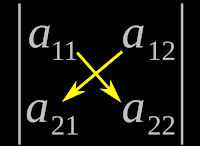In the previous section, we completed a discussion on matrices. In this chapter, we will see determinants.
Some basics about determinants can be written in 6 steps:
1. Consider any square matrix A.
• Using some simple steps, we can find a unique number related to that matrix.
• This number is called determinant of A.
2. Symbolically, we denote this number as |A|.
♦ It should not be read as modulus of A.
♦ It should be read as determinant of A.
3. There are two more ways for denoting this number:
♦ det(A)
♦ Δ
4. Let us see an example:
If $A = \left[\begin{array}{r}
a &{ b } \\
c &{ d } \\
\end{array}\right]$, then $|A| ~=~ \left|\begin{array}{r}
a &{ b } \\
c &{ d } \\
\end{array}\right|
~=~ \text{det}(A)$
5. Only square matrices have determinants.
6. The determinant can be a real number or a complex number.
• In this chapter we will be dealing with only those determinants, which are real numbers.
Method for finding the determinant of a 2 × 2 matrix
• This can be written in 3 steps:
1. Let A = $\left[\begin{array}{r}
a_{11} &{ a_{12} } \\
a_{21} &{ a_{22} } \\
\end{array}\right]$
2. Then det(A) = |A| = $\left|\begin{array}{r}
a_{11} &{ a_{12} } \\
a_{21} &{ a_{22} } \\
\end{array}\right|~=~a_{11}a_{22}~-~a_{21}a_{12}$
3. Note that, there are two terms in the determinant.
• Each term is a product of two elements, taken in a specified order. This order is indicated by the yellow arrows in fig.20.1 below:
 |
| Fig.20.1 |
• After calculating the two terms, we subtract the second term from the first.
Solved example 20.1
Evaluate $\left|\begin{array}{r}
2 &{ 4 } \\
-1 &{ 2 } \\
\end{array}\right|$
Solution:
$\left|\begin{array}{r}
2 &{ 4 } \\
-1 &{ 2 } \\
\end{array}\right|$ = 2(2) − 4(−1) = 4+4 = 8
Solved example 20.2
Evaluate $\left|\begin{array}{r}
x &{ x+1 } \\
x-1 &{ x } \\
\end{array}\right|$
Solution:
$\begin{array}{ll} {~\color{magenta} 1 } &{{}} &{\left|\begin{array}{c} x &{ x+1 } \\ x-1 &{ x } \\ \end{array}\right|} & {~=~} &{x(x)-(x+1)(x-1)} \\
{~\color{magenta} 2 } &{{}} &{{}} & {~=~} &{x^2-(x^2 – 1)} \\
{~\color{magenta} 3 } &{{}} &{{}} & {~=~} &{x^2- x^2 + 1} \\
{~\color{magenta} 4 } &{{}} &{{}} & {~=~} &{1} \\
\end{array}$
Method for finding the determinant of a 3 × 3 matrix
• Consider the 3 × 3 matrix A = $\left[\begin{array}{r}
a_{11} &{ a_{12} } &{ a_{13} } \\
a_{21} &{ a_{22} } &{ a_{23} } \\
a_{31} &{ a_{32} } &{ a_{33} } \\
\end{array}\right]$
• We want $\left|\begin{array}{r}
a_{11} &{ a_{12} } &{ a_{13} } \\
a_{21} &{ a_{22} } &{ a_{23} } \\
a_{31} &{ a_{32} } &{ a_{33} } \\
\end{array}\right|$
• Let us use the first row R1. It can be done in 4 steps:
Step 1:
• Take the first element of R1, which is a11.
• Delete the row in which a11 is situated.
• This is indicated by the yellow rectangle in fig,20.2(a) below:
 |
| Fig.20.2 |
• Delete the column in which a11 is situated.
• This is indicated by the green rectangle in fig,20.2(a) above.
• Now write the following three items:
(i) The 2 × 2 determinant obtained by deleting the row and column.
(ii) Element which is under consideration. Here it is a11.
(iii) (-1)s, where s is the sum of the suffices of a11.
So (-1)s = (-1)1+1.
• Finally, multiply the three items together. We get:
$(-1)^{1+1} \times a_{11} \times \left|\begin{array}{r}
a_{22} &{ a_{23} } \\
a_{32} &{ a_{33} } \\
\end{array}\right|$
Step 2:
• Take the second element of R1, which is a12.
• Delete the row in which a12 is situated.
• This is indicated by the yellow rectangle in fig,20.2(b) above.
• Delete the column in which a12 is situated.
• This is indicated by the green rectangle in fig,20.2(b) above.
• Now write the following three items:
(i) The 2 × 2 determinant obtained by deleting the row and column.
(ii) Element which is under consideration. Here it is a12.
(iii) (-1)s, where s is the sum of the suffices of a12.
So (-1)s = (-1)1+2.
• Finally, multiply the three items together. We get:
$(-1)^{1+2} \times a_{12} \times \left|\begin{array}{r}
a_{21} &{ a_{23} } \\
a_{31} &{ a_{33} } \\
\end{array}\right|$
Step 3:
• Take the third element of R1, which is a13.
• Delete the row in which a13 is situated.
• This is indicated by the yellow rectangle in fig,20.2(c) above.
• Delete the column in which a13 is situated.
• This is indicated by the green rectangle in fig,20.2(c) above.
• Now write the following three items:
(i) The 2 × 2 determinant obtained by deleting the row and column.
(ii) Element which is under consideration. Here it is a13.
(iii) (-1)s, where s is the sum of the suffices of a13.
So (-1)s = (-1)1+3.
• Finally, multiply the three items together. We get:
$(-1)^{1+3} \times a_{13} \times \left|\begin{array}{r}
a_{21} &{ a_{22} } \\
a_{31} &{ a_{32} } \\
\end{array}\right|$
Step 4:
•
This is the final step. Here we add the results obtained in the above three steps.
•
The sum thus obtained is the determinant of A. We can write:
◼ The above process by which we apply the four steps to find the determinant of order 3, is known as expansion along R1.
In the next section, we will see the process of finding the determinant by expansion along R2.
Copyright©2024 Higher secondary mathematics.blogspot.com

No comments:
Post a Comment